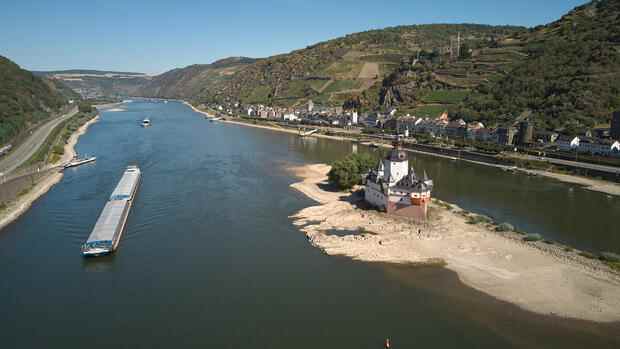Because of the low water levels on the rivers, transport capacities are becoming scarce.
(Photo: dpa)
Dusseldorf Germany’s freight rail logisticians currently see little opportunity to compensate for the supply bottlenecks caused by the low water. This means that companies can hardly shift their transports from inland waterways to rail.
“Our utilization rate is already exceptionally high,” reports a spokesman for Europe’s largest wagon hire company, the Hamburg-based logistics company VTG. Transport capacities for mineral oil, agricultural and chemical products can only be obtained if wagons are returned by customers.
There is also no reserve of discarded wagons, reports the owner of 94,000 freight wagons across Europe – and thus rejects the proposal by Oliver Luksic (FDP). In a newspaper interview, the federal government’s logistics coordinator called for “also using freight wagons that no longer meet the applicable noise protection standards”. This should ensure a stable energy supply.
“We have long since converted all of our transport wagons to the latest legal standards,” says VTG – there are simply no longer any old freight wagons.
Top jobs of the day
Find the best jobs now and
be notified by email.
So far, however, not even Deutsche Bahn has received ad hoc requests to take over the coal transports that have been canceled on the rivers. The short-term conversion of the charging infrastructure is so difficult that many companies are accepting the sharp rise in freight prices on the rivers, according to DB circles. In addition: According to its own statements, Deutsche Bahn does not have an emergency reserve either.
Low water levels: restricted transport to southern Germany
The Bahntower views the latest amendment to the “Energy Security Act” accordingly, which gives priority to rail deliveries to power plants. The law provides security, but is currently not necessary.
Meanwhile, the water levels of important rivers such as the Rhine, Danube, Elbe and Oder have continued to fall in the past few days. The Federal Waterways and Shipping Administration (WSV) predicts stabilization in the area between 30 and 35 centimeters for the Middle Rhine near Kaub, the lowest point of the Rhine, over the course of the week. Below 30 centimeters, inland shipping to the south has to be almost completely stopped. The Duisburg-Ruhrort level on the Lower Rhine is currently around 150 centimeters, with a further downward trend.
In particular, transports to southern Germany are currently only possible to a limited extent. The undeveloped section of the Danube between Straubing and Vilshofen represents a bottleneck here.
Rainy weather is forecast for the coming weekend, and according to the forecast by the WSV, the levels are likely to rise again. The water levels usually normalize within a few days as soon as it rains more heavily. The impact is currently less on impounded rivers such as the Moselle, Neckar and Main and in the canals because less water flows off there.
So far there have been no inquiries about shifting coal transports to power plants to rail, according to Deutsche Bahn.
(Photo: IMAGO/Arnulf Hettrich)
The current low water, sometimes with record lows, once again reveals the bottlenecks in the German waterway network, some of which have been known for decades – especially on the Rhine, Danube and Elbe. Not only the supply of power plants with coal is currently faltering. Steel producers like Thyssen-Krupp and chemical companies like BASF, which obtain most of their raw materials via the Rhine, also have to worry about their supply chains.
Bargemen versus federal government
The Federal Association of German Inland Shipping (BDB) is therefore sharply attacking the federal government. “Absolutely counterproductive” is the reduction in the waterway budget of around 360 million euros planned by Federal Finance Minister Christian Lindner (FDP) from the beginning of next year. “The waterways and shipping administration will run out of money with this,” fears BDB Managing Director Jens Schwanen. The expansion of the river will then, at best, be slowed down.
At the end of July, the federal government admitted to delays in its answers to a parliamentary question: almost all new river expansion projects that were decided in the Federal Transport Infrastructure Plan in 2016 and included in the Waterway Expansion Act have barely progressed beyond the first planning stage. Finished expansions are still “decades away”.
The BDB is therefore calling for faster expansion. Measures such as increasing the depth of the fairway on the Middle Rhine must be implemented as quickly as possible. The project should enable 20 centimeters more draft on this section of the Rhine. In practice, according to Schwanen, this means: “The cargo ship can take on significantly more cargo, and it can stay underway for significantly longer when the tide is low.”
>> Read also: The low water in the Rhine is also a political failure
The low water levels create considerable additional work for inland shipping, since each ship can take on less cargo than usual. At the current water level at the Kaub gauge, an inland waterway vessel, which can usually transport around 4,000 tons of cargo, can only load a maximum of 1,000 tons. To compensate, the load has to be distributed among several ships, whereby smaller barges with a length of 65 to 85 meters can often only transport 100 tons – as much as four trucks.
In addition, the demand for transport by barge has been extremely high in recent weeks. Shippers have been almost fully booked for months for groups of goods such as coal, grain, animal feed, building materials and chemical products.
Transport capacities for 200,000 tons would also be shifted to the Danube to transport fertilizers and agricultural products for Ukraine. As a result, there are even fewer options, the inland shipping association complains. The quadrupling of freight rates, with which many shipping companies allow themselves to be compensated for the additional effort, should nevertheless ensure their economic livelihood.
More: How the drought is endangering Europe’s supply
